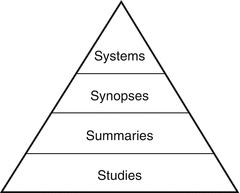(1)
Department of Neurology Neurosciences Centre, and Clinical Epidemiology Unit, All India Institute of Medical Sciences, New Delhi Delhi, India
Abstract
Once your question is well formulated, you need to find the current best evidence to answer the question. To do this efficiently, you may do two things: one, to ask a colleague, and two, to search for evidence. The colleague may guide you to the latest and best evidence or give you some information to facilitate your search. In any case, I think it is good to search some online sources so that you don’t miss a recent article. A third source can be the company representatives, who come to inform you of their newer products and claim their (products’) superiority or effectiveness. You may ask them to bring reprint of original articles to substantiate their claim.
Once your question is well formulated, you need to find the current best evidence to answer the question. To do this efficiently, you may do two things: one, to ask a colleague, and two, to search for evidence. The colleague may guide you to the latest and best evidence or give you some information to facilitate your search. In any case, I think it is good to search some online sources so that you don’t miss a recent article. A third source can be the company representatives, who come to inform you of their newer products and claim their (products’) superiority or effectiveness. You may ask them to bring reprint of original articles to substantiate their claim.
In any case, an online search is always advisable [1]. A list of information resources for online search is provided below.
Information Resources
Four categories are described [2]:
1.
Studies: Primary or original studies, for example, those retrieved from MEDLINE/PubMed. More than 20 million articles are indexed in MEDLINE. They need appraisal for clinical application.


2.
Syntheses or summaries: For example, Cochrane review which provides systematic reviews of health-care interventions.
3.
Synopses: There are pre-appraised abstracts published as journals, for example, ACP Journal Club or Evidence-Based Medicine or Evidence-Based Nursing. For a list of pre-appraisal resource journals in various disciplines, refer to www.ebmny.org/journal.html
4.
Systems: These usually integrate various types of health-care information like clinical evidence, guidelines, primary studies, summaries and synopses. Examples include UpToDate (www.uptodate.com), Clinical Evidence (www.clinicalevidence.com) and Dynamed (https://dynamed.ebscohost.com)
Three search systems, which are free resources, comprehensive and easy to use and list all types of evidence resource, are:
1.
Sumsearch
2.
TRIP
3.
Google (including Google Scholar)
First two are often good resources to begin your search.
Searching the PubMed
PubMed is free and probably the most commonly searched system. The system keeps improving on regular basis and by the time you read this, the system may have added new features. It may be useful to keep in mind:
1.
Simple searching: Just type in a word, phrase, series of phrases or a sentence in the searching box. Click ‘search’ and you will get the hits. The choice of word or phrase should be based on your question, probably in PICO format. Order may be any, but often the ‘intervention’ and ‘patients’ yield more useful results.
2.
Related articles and reviews: On the right of the list of articles retrieved, you will find some citations of related articles and below them two options – ‘reviews’ and ‘all related articles’. You may click on them to expand your search. The retrieved articles may be sorted by ‘publication date’ using the display button.
3.
Clinical queries: PubMed has this search feature (you may find this on the lower half of homepage of PubMed or when you enter “PubMed” in ‘Google’, you may have the option to directly click PubMed clinical queries). Here, you can put a term and click search. There is already a search strategy but into ‘clinical queries’ which gives you relevant studies as well as systematic reviews on the topic and also option of ‘broad’ or ‘narrow’ search and types of articles like ‘therapy’, ‘diagnosis’ and ‘prognostic’.
4.
Limits: The option helps you to limit your retrieval in PubMed to publication type (like meta-analysis), age and sex of study subjects, year of publication (like last 5 years), language (like English), etc. The option is available in two ways:
(i)
In direct PubMed search, all these options are displayed on left panel and you may click in as many as you want to limit your search.
(ii)
It is also available as button below the search box.
Stay updated, free dental videos. Join our Telegram channel

VIDEdental - Online dental courses


